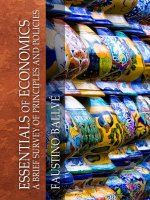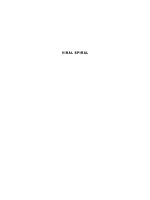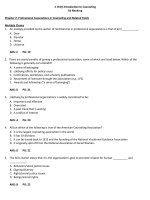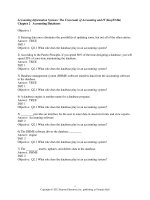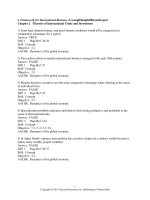How the world works a brief survey of international relations 1st edition bova test bank
Bạn đang xem bản rút gọn của tài liệu. Xem và tải ngay bản đầy đủ của tài liệu tại đây (281.84 KB, 18 trang )
Instructor’s Manual /
Test Bank
to accompany
Russell Bova’s
How the World Works:
A Brief Survey of International Relations
First Edition
Prepared by:
Juris Pupcenoks & Vittorio Nicholas Galasso
University of Delaware
Longman
New York Boston San Francisco
London Toronto Sydney Tokyo Singapore Madrid
Mexico City Munich Paris Cape Town Hong Kong Montreal
i
© 2010 Pearson Education Inc., Publishing as Longman
Instructor’s Manual/ Test Bank to accompany Bova’s How the World Works: A Brief Survey of
International Relations, First Edition
Copyright © 2010 Pearson Education, Inc.
All rights reserved. Printed in the United States of America. Instructors may reproduce
portions of this book for classroom use only. All other reproductions are strictly
prohibited without prior permission of the publisher, except in the case of brief
quotations embodied in critical articles
and reviews.
1 2 3 4 5 6 7 8 9 10——11 10 09 08
Longman
is an imprint of
www.pearsonhighered.com
ISBN: 0205681166
ii
© 2010 Pearson Education Inc., Publishing as Longman
Table of Contents
Chapter 1: How to Think About World Politics: Realism and Its Critics . . . . . . . . . . . . . . . . . . 1
Chapter 2: Historical Perspectives: Continuity and Change in World Politics. . . . . . . . . . . . . 15
Chapter 3: Levels of Analysis: The Making of Foreign Policy. . . . . . . . . . . . . . . . . . . . . . . . . . . 30
Chapter 4: War and Violence in World Politics: The Realist’s World. . . . . . . . . . . . . . . . . . . . 44
Chapter 5: International Law and Organization: The Promise of Liberal Institutionalism. . . 57
Chapter 6: The Human Rights Revolution: The Construction of International Norms. . . . . . 70
Chapter 7: Economic Globalization: The Consequences of Liberal Commercialism. . . . . . . . 83
Chapter 8: Transnational Actors and Issues: The State System under Stress . . . . . . . . . . . . . . 97
Chapter 9: Global Futures. . . . . . . . . . . . . . . . . . . . . . . . . . . . . . . . . . . . . . . . . . . . . . . . . . . . . . . . 110
iii
© 2010 Pearson Education Inc., Publishing as Longman
CHAPTER 1: How to Think About World Politics:
Realism and its Critics
Learning Objectives
After reading this chapter, students should understand:
•
•
•
•
•
•
•
•
•
•
the meaning and utility of paradigms
the difference between classical realism and neo-realism
the concepts of anarchy and sovereignty and their impact on state behavior
the concepts of self help and balance of power
the place assigned to considerations of interests and power vs. ethics and justice in the
realist paradigm
the liberal paradigm, its various subtypes, and the concept of the Kantian triangle
the constructivist challenge to both realism and liberalism
the feminist paradigm of international relations
the neo-Marxist paradigm
the central differences between realists and their various critics
Chapter Summary
This chapter introduces the general concept of paradigms and discusses their utility in helping
students and scholars to understand how the world of international relations works. The central
goal is to show students that there are competing perspectives from which to describe and
explain how the world works. Starting with the realist paradigm, there is a brief comparison of
classical realism (human nature realism) and neo-realism (structural realism), followed by an
extended discussion of the latter. The core neo-realist assumptions of international anarchy, state
sovereignty, and states as rational unitary actors are examined in detail and followed by
discussion of their implications for state behavior. The chapter explains why neo-realists see
anarchy leading to self-help, the security dilemma, war, balance of power, and an emphasis on
power over justice in the conduct of international relations. The discussion of realism is then
followed by an explanation of the liberal paradigm, its various subtypes, and the concept of the
Kantian triangle that serves to bring the various subtypes of liberalism together. That is followed
by a discussion of constructivism, with an emphasis on points of agreement with and divergence
from both realism and liberalism. Finally, the chapter then examines the feminist and neoMarxist paradigms of international relations. The chapter concludes with a summary of the five
major paradigms, and it explains to students that the material in the chapters that follow will help
them to evaluate the utility of these contending ways of thinking about how the world works.
1
© 2010 Pearson Education Inc., Publishing as Longman
Lecture Outline
I. All Politics is Global
1). Individuals’ lives are affected by world politics.
a). The economy
b). The environment
c). Physical security
d). Globalization intensifies these effects
II. Studying International Relations and World Politics
1). Used interchangeably, though distinct
a). International Relations
b). World Politics
2). Different from journalism/punditry
a). Journalists: Describe & analyze
b). Scholars: Look for generalizations, patterns, and causality to create theories
3). Paradigm
a). Broad framework for theory development
b). Puzzles
c). Paradigms in the natural sciences
d). In the social sciences
e). Cautionary points
f). Ideal types
III. The Realist Paradigm
1). Realism
a). Pursuit of power
b). Competition
c). Military/material capabilities
d). Violence
2). Human nature realists (classical realists)
a). Human nature
3). Structural realists (neo-realists)
a). Anarchy
b). Sovereignty
c). Rational unitary actors
d). Self help
e). Security dilemma
f). War is inevitable
g). Balance of power
g1). Balancing versus bandwagoning
h). Power triumphs justice
h1). Melian dialogue
i). Politics is not about good versus evil
j). Cooperation is fleeting
2
© 2010 Pearson Education Inc., Publishing as Longman
IV. Alternatives to Realism
1). Realism has critics
a). Changes in world politics threatened realism’s dominance
V. Liberalism
1). Idealism versus realism
2). Liberalism
a). Cooperation is possible
b). Absolute gains instead of relative gains
3). Kant’s Perpetual Peace
a). Federation of free states
b). spirit of commerce
c). Republicanism
4). Liberal Institutionalism
a). International institutions mitigate realist anarchy
b). International Organizations
5). Liberal Commercialism
a). “Spirit of commerce”
b). capitalist peace
c). War is bad for business
d). Economic globalization
6). Liberal Internationalism
a). “Republicanism”
b). Expanding democracies around the world
c). Democratic Peace Theory
7). The Kantian Triangle
a). Security dilemma replaced with “virtuous circle”
VI. Constructivism
1). The “Constructivist turn”
a). Inability of realism and liberalism to explain the end of the Cold War
2). Constructivist perspective
a). Structure is not all determining
a1). Anarchy is what states make of it
a2). Role of human agency
b). Norms and ideas
c). Individuals/non-state actors
c1). Social movements, TANs
VII. Feminism
1). A male dominated perspective of the world
2). Women with political authority would change the conduct of international relations
3). Feminism’s place in IR theory
4). Realism as a gendered perspective
a). IR theorists and gender
5) Foreign policy-making as a male perspective
3
© 2010 Pearson Education Inc., Publishing as Longman
a). Men dominate the conduct of international relations
6) Feminism and other theories of IR
VIII. Neo-Marxism
1). Rise of communism in 20th century
2). An alternative view of world politics
3). Shares many assumptions of realism
a). Structural determinism
b). Pessimism
4). Diverges from realism
a). states versus classes (workers against capitalists)
b). Economics drives politics, not the other way around
Key Terms
•
•
•
•
•
•
•
•
•
•
•
•
•
•
•
•
•
•
•
•
•
•
•
•
•
•
•
•
Absolute gains
Anarchy
Balance of Power
Balancing
Bandwagoning
Capitalism
Class interests
Cold War
Constructivism
Democratic Peace Theory
Feminism
Gender
Globalization
Ideal type
International Organizations (IO)
International Relations
Interdependence
Journalism
Liberalism
Neo-Marxism
Non Governmental Organization (NGO)
Non-state actors
Norms
Paradigm
Peace of Westphalia
Political movement
Political Scientist
Power
4
© 2010 Pearson Education Inc., Publishing as Longman
•
•
•
•
•
•
•
•
•
•
•
Realism
Relative gains
Security dilemma
Self help
Social science
Structure
Sovereignty
State of nature
Theory
Transnational Advocacy Networks (TAN)
World politics
Connecting to the Text
Using “IR at the Movies” and “Theory and Practice”
IR at the Movies
The Godfather Trilogy
• Initiate class discussion of the IR theories from the chapter by asking the following
questions: What factors contribute to the security dilemma among the “five families” in
the movie The Godfather? How does the character Virgil “The Turk” Sollozzo attempt to
realign the balance of power among the “five families”? How might feminist scholars
analyze, The Godfather? What might be different from how the “family” conducts
business if it was operated by women? In the film, A Beautiful Mind, actor Russell Crowe
plays Nobel laureate John Nash. In the film, Nash first realizes his famous equilibrium in
a bar and tells his friends that, “Adam Smith is wrong.” How does Nash’s Equilibrium, as
explained to his friends in the bar, relate to the absolute gains argument espoused by
Liberal IR theory?
Theory and Practice
1.1 Youth Gangs: Theory and Practice
• Divide the class into small working groups. First, ask each group to generate a list of
characteristics that represent the behavior of street gangs. Secondly, ask the group to
make comparisons between the characteristics of street gangs to what they recently
learned about the realist perception of the international system.
5
© 2010 Pearson Education Inc., Publishing as Longman
Connecting to the Sources
The below articles are found in Bova, Readings on How the World Works
John J. Mearsheimer, “The Tragedy of Great Power Politics”
In his book, Mearsheimer articulates that the competition among states to become the system’s
hegemon is transhistorical.
• What reasons does Mearsheimer provide for his pessimistic outlook regarding the
possibility of sustained world peace?
• How does Mearsheimer characterize the differences between offensive and defensive
realism?
Bruce Russett and John Oneal, “International Systems: Vicious Circles and Virtuous Circles”
The authors argue that the competition for power can be overcome through cooperation and a
sustained peace among states is possible.
• According to Russett and Oneal, what predictions about the nature of world politics do
realists get wrong?
Alexander Wendt, “Constructing International Politics”
Wendt tells us that the character of international politics depends on the perceptions states have
of one another. If states are suspicious of other states, then we should expect realist outcomes.
However, if states trust each other, then we should expect liberal outcomes.
• How does Wendt challenge the theoretical assumptions made by realism and liberalism?
Connecting to the Web
The below resources are available at www.MyPoliSciKit.com
•
•
•
•
•
Simulation: Complete and submit answers to the review questions for:
o Why Study International Relations.
Videos. Watch and submit answers to the review questions for one of the following:
o Al Qaeda and the Taliban in Pakistan
o Nuclear Disarmament Under the INF Treaty
o Chamberlain’s Appeasement.
Mapping Exercises: Review your knowledge of the world’s geography in this online
quiz.
Practice Test: Check your comprehension of the concepts presented in the text by taking
the practice test for Chapter 1. The online flashcards can also be used to test your
vocabulary.
Current Events Quiz: Complete this week’s current events quiz to test your knowledge of
major international events.
6
© 2010 Pearson Education Inc., Publishing as Longman
Assessment
Multiple Choice Questions
1. Which of the following is NOT true about “virtuous circles” of mutual interests and
cooperation?
a. International institutions play an important role in their creation.
b. Overly extensive economic interactions between states harm them. (p. 23-4,
comprehension)
c. They can be created through policy action.
d. Vicious circles can be turned into virtuous circles.
2. A situation where one state makes its neighbors less secure through pursuit of its own
security is known as:
a.
b.
c.
d.
Pursuit of power.
Bandwagoning.
State of nature.
Security dilemma. (p. 11; comprehension)
3. Which of the following is NOT an element of the Kantian triangle?
a.
b.
c.
d.
Institutions
Virtuous circle (p. 24; knowledge)
Democracy
Economic interdependence
4. Which of the following international relations paradigms gained its popularity at the end
of the Cold War?
a.
b.
c.
d.
Realism
Constructivism (p. 24; knowledge)
Liberalism
Neo-Marxism
5. Wendt and constructivists disagree with realists on which of the following points?
a.
b.
c.
d.
States wish to survive.
In many cases, states seek power in international relations.
Anarchy is unavoidable. (p. 25; application)
States are important players in contemporary international relations.
7
© 2010 Pearson Education Inc., Publishing as Longman
6. Which paradigm is the most likely to agree with the statement, “might makes right”?
a.
b.
c.
d.
Constructivism
Liberalism
Feminism
Realism (p. 15; application)
7. According to constructivists, what two forces shape and construct the system in which
states operate?
a.
b.
c.
d.
State power and human beings.
Structure and human beings. (p. 25; -comprehension)
State power and desire to survive.
The logic of anarchy and norms.
8. Which of the following is NOT one of the ways in which international organizations
reduce anarchy?
a.
b.
c.
d.
They regulate and constrain the behavior of states.
They promote cooperation.
They help to create a balance of power. (p. 21; comprehension)
They promote international law.
9. Which of the following is NOT one of the tenets of liberalism?
a.
b.
c.
d.
Democracies tend to act differently than non-democracies.
Economic calculations matter greatly in determining state action.
Mutually beneficial cooperation is possible.
Zero-sum game considerations matter greatly in determining state action. (p. 22;
comprehension)
10. What is anarchy?
a.
b.
c.
d.
A situation where one state makes all the rules
Absence of world government (p. 7; knowledge)
A goal of international politics
A situation where a group of states make all the rules
11. Feminists claim that having more women in power would:
a.
b.
c.
d.
Make international relations more peaceful. (p. 30; knowledge)
Not have a significant impact on political conduct.
Make international relations more interesting.
Make international relations more just.
8
© 2010 Pearson Education Inc., Publishing as Longman
12. What is the main problem that feminist scholars have with international relations?
a. Women still do not have the right to vote in most parts of the world.
b. Scholars pay too much attention to the study of international relations at the
expense of other, more important fields, such as economics.
c. Men dominate the conduct of international relations. (p. 28; comprehension)
d. Anarchy is what states make out of it.
13. According to realists, order in international relations can be achieved through:
a.
b.
c.
d.
Bandwagoning.
Joining of international institutions.
Class struggle.
Balance of power. (p. 14; knowledge)
14. According to constructivists, which of the following does NOT have an unavoidable
impact on the behavior of states?
a.
b.
c.
d.
Anarchy (p. 25; comprehension)
Material resources
Shared knowledge
Ideas
15. Which one of the following is NOT a feature of the “structure of the international
system” for realists?
a.
b.
c.
d.
Absence of central authority
Possibility of threat presented by other states
Norms of behavior (p. 7; comprehension)
Uncertainty of other states’ intentions
16. According to liberals, what steps can be taken to promote peace and cooperation?
a.
b.
c.
d.
Promote economic interdependence
Promote democracy
Pursue hegemony
A and B (p. 20-21; knowledge)
17. Which of the following scholars is associated with liberalism?
a.
b.
c.
d.
Immanuel Kant (p. 20; knowledge)
Alexander Wendt
John Mearsheimer
Thomas Hobbes
9
© 2010 Pearson Education Inc., Publishing as Longman
18. Which of the following statements is a tenet of the democratic peace theory?
a.
b.
c.
d.
Democratic peace is possible if democracies integrate militarily.
Democracies typically do not fight other democracies. (p. 22; comprehension)
Democracies are militarily stronger than non-democracies.
Democracies will stop fighting when most of the countries of the world become
democratic.
19. Which of the following is NOT an example of an international institution promoting
liberal principles?
a.
b.
c.
d.
United Nations
League of Nations
Warshaw Pact (p. 21; knowledge)
None of the above
20. What is the main lesson from the “Melian dialogue”?
a.
b.
c.
d.
Justice can prevail only through struggle.
Alliances are not durable.
Survival depends on power. (p. 17; comprehension)
World politics is primarily about good and evil.
21. What do constructivists believe about state interests?
a.
b.
c.
d.
They are externally determined and constant.
They do not matter.
They are socially constructed. (p. 25; comprehension)
They are determined based on state military and economic power.
22. Which important event encouraged many scientists to become more skeptical of realism?
a. The end of American Civil War
b. The end of World War II
c. The end of the Cold War (p. 19; knowledge)
d. Decolonization
23. With which of the following statements are liberals most likely to agree?
a.
b.
c.
d.
The goal of politics is the creation of a balance of power.
The goal of politics is the pursuit of power.
There are good and bad states. (p. 20-21; comprehension)
We need to question the foundational myths of international relations.
10
© 2010 Pearson Education Inc., Publishing as Longman
24. Which of the following statements is NOT true about Neo-Marxism?
a.
b.
c.
d.
It shares several assumptions with realism.
It is a structural theory.
It believes that conflict drives world politics.
It has gained popularity since the end of the Cold War. (p. 33; knowledge)
25. What is the balance of power model?
a. An instance when power of one state or alliance is balanced by another state or
alliance. (p. 14; knowledge)
b. An instance when there is a similar number of liberal and illiberal states in the
international system.
c. A system where there is a similar number of male and female representatives in
foreign affairs.
d. A system where there is no serious conflict between the different class interests.
26. What has led to an increasing interconnectedness among people of the world in recent
decades?
a.
b.
c.
d.
Growth of the world population
Increases in wealth
Benevolent dominance of the U.S.
Developments in technology and telecommunications (p. 4; comprehension)
27. What is an ideal type?
a.
b.
c.
d.
A world with a perfect balance of power
A paradigm stated in its pure and almost exaggerated form (p. 6; knowledge)
A world without wars and conflicts
None of the above
28. Which of the following variables do neo-Marxists emphasize in their explanations of
world politics?
a.
b.
c.
d.
Class interests (p. 34; knowledge)
Pursuit of national interest
Ideas and norms
Actions of international organizations
11
© 2010 Pearson Education Inc., Publishing as Longman
29. What do feminists think about the structure of the international system?
a. It forces states to act in certain ways to ensure their survival.
b. It promotes struggle between the rich and poor.
c. It is the most important factor in determining state behavior, yet gender also
influences decision-making.
d. It does not have as much influence on state actions as the gender of the decisionmakers. (p. 30; comprehension)
30. In many aspects, what is the current dominant paradigm?
a. Realism (p. 36, knowledge)
b. Liberalism
c. Constructivism
d. Feminism
True/False Questions
1. There are very few influential women international relations scholars. (T; p. 29;
knowledge)
2. For realists, anarchy is what a state makes out of it. (F; p. 7; knowledge)
3. Paradigms simplify the reality and in their explanations reduce the complexity of the
world. (T; p. 5; knowledge)
4. According to constructivists, norms are rules of behavior imposed by the strongest state
in the system. (F; p. 26-7; comprehension)
5. In self-help systems, power and self interest determine state behavior. (T; p. 10;
knowledge)
6. Realists believe that cooperation can be achieved if states create international institutions.
(F; p. 18; knowledge)
7. Constructivists agree with realists that power-seeking, self-help, and war are
contemporary facts of international life (T; p. 25; knowledge)
8. Feminists think that most states have overly militaristic approach to foreign relations. (T;
p. 30; knowledge)
9. Neo-Marxism has increased in popularity since the end of the Cold War. (F; p. 33;
knowledge)
10. Vicious circles of war and mistrust can be replaced by virtuous circles of mutual interests
and cooperation through punitive military operations against aggressors. (F; p. 19;
knowledge, p. 20-1)
12
© 2010 Pearson Education Inc., Publishing as Longman
11. Liberals see interaction in international relations as a zero-sum game. (F; p. 20;
application)
12. Constructivists believe that due to globalization, nongovernmental organizations are the
most important contemporary actors in the world politics. (F; p. 25; comprehension)
13. Contemporary feminist perspectives took hold in the 1950s following the end of World
War II. (F; p. 29; knowledge)
14. Liberals believe that state internal differences influence different behavioral patterns. (T,
p. 22; knowledge)
15. For realists, calculation about economic gains is an important variable influencing state
decision-making. (F; p.7, 20; comprehension)
16. The European Union is an example of a security dilemma. (F; p. 11; application)
17. Neo-Marxism shares a few important assumptions with realism. (T; p. 33; knowledge)
18. Neo-Marxists apply power and an ideas-based framework to a wide range of economic
events. (F; p. 34; knowledge)
19. Transnational advocacy networks are composed of state officials and nonstate actors. (F;
p. 27; knowledge)
20. Feminists argue that women have less of a “realist” world view. (T; p. 31; knowledge)
Short Answer Questions
1. Why would it be hard to sell realism to American or European people?
2. Why do realists think wars are inevitable?
3. What are the main differences between how realists and constructivists view the
“structure”?
4. Why do liberals insist that economic interdependence lessens the possibility of conflict?
5. According to liberals, how do international institutions mitigate anarchy?
6. How does constructivism explain the end of the Cold War?
7. What is the security dilemma?
8. How could feminists respond to critics that argue that some women in power are as
inclined to use violence as men?
9. What is the difference between balancing and bandwagoning?
10. What is the difference between human nature realists (classical realists) and structural
realists (neo-realists)?
13
© 2010 Pearson Education Inc., Publishing as Longman
Essay Questions
1. What is the nature of world politics according to each of the major paradigms discussed?
2. How is the security dilemma replaced with “virtuous circle” in the “Kantian Triangle”?
Define and explain your concepts.
3. What is constructivist critique of realism?
4. What do realists, liberals, and constructivists think about anarchy?
5. Describe a realist critique of constructivist emphasis on ideas and norms, and provide
examples.
6. What actions and changes to the study and practice of international relations would
feminist scholars suggest to ensure that the field is more gender-sensitive?
7. Which theory (realism, liberalism, constructivism, feminism, or neo-Marxism) explains
international relations the best and why? Provide examples in your answer.
8. In what ways, according to feminists, is the field of international relations dominated by
men and men’s perspectives?
9. Why do liberals believe cooperation is possible? Explain and define various terms and
concepts discussed in the book and in class, and provide examples.
10. What, according to constructivists, is the role of ideas and norms in state conduct in
international relations? How do states acquire their identities?
14
© 2010 Pearson Education Inc., Publishing as Longman
CHAPTER 2: Historical Perspectives:
Continuity and Change in World Politics
Learning Objectives
After reading this chapter, students should understand:
•
•
•
•
•
•
•
•
•
•
•
the concepts of nation, state, and nation-state
the difference between the classical and concert models of balance of power
the 19th century “Concert of Europe” system of order
the difference between balance of power and collective security systems
the factors that led to the failure of the League of Nations system
the options for a system of order that were considered after World War II
the characteristics of multipolar, bipolar, and unipolar systems and periods in
international relations history characterized by each
the emergence, nature, and end of the US-Soviet Cold War
trends in world politics since the end of the Cold War era
the pattern of war, creation of a system of order, and breakdown of that system that has
repeated over the past four centuries
how and why realists and their critics see the question of continuity and change in
international relations differently
Chapter Summary
This chapter looks at six eras in the history of international relations from 1648 to the present.
The central goal is to get students to assess elements of continuity (stressed by realists) versus
change (stressed by many critics of realism) in how the world has worked since 1648. A theme
of the chapter is the pattern of war, leading to post-war efforts to design a new system of order,
which eventually breaks down and leads to another war or major crisis. We see this first in the
Thirty Years War, leading to the Peace of Westphalia, and eventually the emergence of the
classical balance-of-power system based on the sovereign state. The Napoleonic Wars bring this
first era to an end and are followed by at a new effort at order based on the concert model of
balance of power (the Concert of Europe). World War I leads US President Wilson to look for an
entirely new approach to order based on the concept of collective security as manifested in the
League of Nations, but that experiment is ended by the outbreak of World War II. The 1945
Yalta Conference and other meetings among the victors of that war eventually lead to a new era
of Cold War bipolarity that lasts until the fall of the Berlin Wall in 1989 and the collapse of the
USSR in 1991. The Post-Cold War Era, marked by globalization, democratization, and US
hegemony, is brought to a symbolic end by the terror attacks of September 11, 2001. The
contours of “Post-Post-Cold War Era” are still unfolding. The chapter concludes by asking
students to consider whether they are more impressed by the elements of change or continuity in
world politics over the past four centuries.
15
© 2010 Pearson Education Inc., Publishing as Longman

